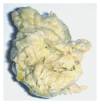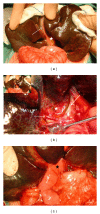Biliary atresia: 50 years after the first kasai
- PMID: 23304557
- PMCID: PMC3523408
- DOI: 10.5402/2012/132089
Biliary atresia: 50 years after the first kasai
Abstract
Biliary atresia is a rare neonatal disease of unknown etiology, where obstruction of the biliary tree causes severe cholestasis, leading to biliary cirrhosis and death in the first years of life, if the condition is left untreated. Biliary atresia is the most frequent surgical cause of cholestatic jaundice in neonates and should be evoked whenever this clinical sign is associated with pale stools and hepatomegaly. The treatment of biliary atresia is surgical and currently recommended as a sequence of, eventually, two interventions. During the first months of life a hepatoportoenterostomy (a "Kasai," modifications of which are discussed in this paper) should be performed, in order to restore the biliary flow to the intestine and lessen further damage to the liver. If this fails and/or the disease progresses towards biliary cirrhosis and life-threatening complications, then liver transplantation is indicated, for which biliary atresia represents the most frequent pediatric indication. Of importance, the earlier the Kasai is performed, the later a liver transplantation is usually needed. This warrants a great degree of awareness of biliary atresia, and the implementation of systematic screening for this life-threatening pathology.
Figures


Similar articles
-
Biliary Atresia: Clinical Lessons Learned.J Pediatr Gastroenterol Nutr. 2015 Aug;61(2):167-75. doi: 10.1097/MPG.0000000000000755. J Pediatr Gastroenterol Nutr. 2015. PMID: 25658057 Review.
-
Biliary atresia.Orphanet J Rare Dis. 2006 Jul 26;1:28. doi: 10.1186/1750-1172-1-28. Orphanet J Rare Dis. 2006. PMID: 16872500 Free PMC article. Review.
-
Biliary atresia: pathogenesis and treatment.Semin Liver Dis. 1998;18(3):281-93. doi: 10.1055/s-2007-1007164. Semin Liver Dis. 1998. PMID: 9773428 Review.
-
Biliary Atresia.2023 Jun 26. In: StatPearls [Internet]. Treasure Island (FL): StatPearls Publishing; 2025 Jan–. 2023 Jun 26. In: StatPearls [Internet]. Treasure Island (FL): StatPearls Publishing; 2025 Jan–. PMID: 30725947 Free Books & Documents.
-
[Screening for biliary atresia and stool colour: Method of colorimetric scale].Arch Pediatr. 2007 Mar;14(3):303-5. doi: 10.1016/j.arcped.2006.12.015. Epub 2007 Feb 5. Arch Pediatr. 2007. PMID: 17276661 Review. French.
Cited by
-
The extended Kasai portoenterostomy for biliary atresia: A preliminary report.J Indian Assoc Pediatr Surg. 2016 Apr-Jun;21(2):66-71. doi: 10.4103/0971-9261.176941. J Indian Assoc Pediatr Surg. 2016. PMID: 27046977 Free PMC article.
-
Early Cholangitis after Portoenterostomy in Children with Biliary Atresia.J Indian Assoc Pediatr Surg. 2019 Jul-Sep;24(3):185-188. doi: 10.4103/jiaps.JIAPS_96_18. J Indian Assoc Pediatr Surg. 2019. PMID: 31258267 Free PMC article.
-
Risk Prediction Scoring System to Predict the Postsurgical Outcomes of Biliary Atresia.J Indian Assoc Pediatr Surg. 2020 Sep-Oct;25(5):280-285. doi: 10.4103/jiaps.JIAPS_118_19. Epub 2020 Sep 1. J Indian Assoc Pediatr Surg. 2020. PMID: 33343108 Free PMC article.
-
False-negative Hepatobiliary Scintigraphy for Biliary Atresia.Nucl Med Mol Imaging. 2019 Oct;53(5):356-360. doi: 10.1007/s13139-019-00606-w. Epub 2019 Aug 21. Nucl Med Mol Imaging. 2019. PMID: 31723366 Free PMC article.
-
Impact of gallbladder hypoplasia on hilar hepatic ducts in biliary atresia.Commun Med (Lond). 2024 Jun 11;4(1):111. doi: 10.1038/s43856-024-00544-5. Commun Med (Lond). 2024. PMID: 38862768 Free PMC article.
References
-
- Davenport M, Bezerra JA, Sokol RJ. A challenge on the use of the words Embryonic and Perinatal in the context of biliary atresia. Hepatology. 2005;41(2):403–405. - PubMed
-
- Davenport M, Tizzard SA, Underhill J, Mieli-Vergani G, Portmann B, Hadžić N. The biliary atresia splenic malformation syndrome: a 28-year single-center retrospective study. Journal of Pediatrics. 2006;149(3):393–400. - PubMed
-
- Chardot C, Carton M, Spire-Bendelac N, Le Pommelet C, Golmard JL, Auvert B. Prognosis of biliary atresia in the era of liver transplantation: French National Study from 1986 to 1996. Hepatology. 1999;30(3):606–611. - PubMed
-
- Chardot C, Carton M, Spire-Bendelac N, Pommelet CL, Golmard JL, Auvert B. Epidemiology of biliary atresia in France: a national study 1986–1996. Journal of Hepatology. 1999;31(6):1006–1013. - PubMed
LinkOut - more resources
Full Text Sources
Molecular Biology Databases
